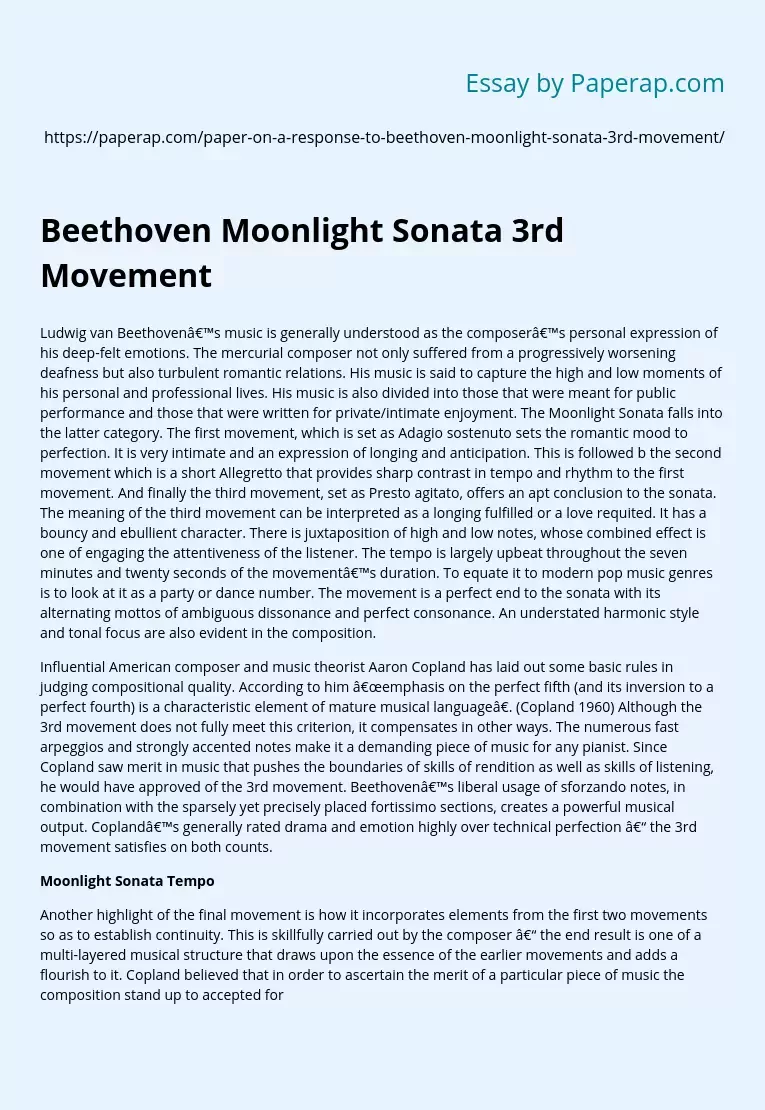Beethoven Moonlight Sonata 3rd Movement
Ludwig van Beethoven’s music is generally understood as the composer’s personal expression of his deep-felt emotions. The mercurial composer not only suffered from a progressively worsening deafness but also turbulent romantic relations. His music is said to capture the high and low moments of his personal and professional lives. His music is also divided into those that were meant for public performance and those that were written for private/intimate enjoyment. The Moonlight Sonata falls into the latter category.
The first movement, which is set as Adagio sostenuto sets the romantic mood to perfection. It is very intimate and an expression of longing and anticipation. This is followed b the second movement which is a short Allegretto that provides sharp contrast in tempo and rhythm to the first movement. And finally the third movement, set as Presto agitato, offers an apt conclusion to the sonata. The meaning of the third movement can be interpreted as a longing fulfilled or a love requited.
It has a bouncy and ebullient character. There is juxtaposition of high and low notes, whose combined effect is one of engaging the attentiveness of the listener. The tempo is largely upbeat throughout the seven minutes and twenty seconds of the movement’s duration. To equate it to modern pop music genres is to look at it as a party or dance number. The movement is a perfect end to the sonata with its alternating mottos of ambiguous dissonance and perfect consonance. An understated harmonic style and tonal focus are also evident in the composition.
Influential American composer and music theorist Aaron Copland has laid out some basic rules in judging compositional quality. According to him “emphasis on the perfect fifth (and its inversion to a perfect fourth) is a characteristic element of mature musical language”. (Copland 1960) Although the 3rd movement does not fully meet this criterion, it compensates in other ways. The numerous fast arpeggios and strongly accented notes make it a demanding piece of music for any pianist. Since Copland saw merit in music that pushes the boundaries of skills of rendition as well as skills of listening, he would have approved of the 3rd movement. Beethoven’s liberal usage of sforzando notes, in combination with the sparsely yet precisely placed fortissimo sections, creates a powerful musical output. Copland’s generally rated drama and emotion highly over technical perfection – the 3rd movement satisfies on both counts.
Moonlight Sonata Tempo
Another highlight of the final movement is how it incorporates elements from the first two movements so as to establish continuity. This is skillfully carried out by the composer – the end result is one of a multi-layered musical structure that draws upon the essence of the earlier movements and adds a flourish to it. Copland believed that in order to ascertain the merit of a particular piece of music the composition stand up to accepted formal standards. But he also appends that no music can be objectively measured – a large part of the process of appreciation actually lies with the listener. To this end, Copland asks two fundamental questions of listeners – “Are they hearing everything that is going on? Are they really being sensitive to it?” (Copland 1960) If we are to answer to both these questions in the affirmative, then the 3rd movement of the Moonlight Sonata cannot fail to excite and delight.
Reference:
Copland, Aaron (1960). Copland on Music. Garden City, NY: Doubleday & Company, Inc.
Ludwig van Beethoven’s music is generally understood as the composer’s personal expression of his deep-felt emotions. The mercurial composer not only suffered from a progressively worsening deafness but also turbulent romantic relations. His music is said to capture the high and low moments of his personal and professional lives. His music is also divided into those that were meant for public performance and those that were written for private/intimate enjoyment. The Moonlight Sonata falls into the latter category. The first movement, which is set as Adagio sostenuto sets the romantic mood to perfection. It is very intimate and an expression of longing and anticipation. This is followed b the second movement which is a short Allegretto that provides sharp contrast in tempo and rhythm to the first movement. And finally the third movement, set as Presto agitato, offers an apt conclusion to the sonata. The meaning of the third movement can be .
Beethoven Moonlight Sonata 3rd Movement. (2019, Dec 05). Retrieved from https://paperap.com/paper-on-a-response-to-beethoven-moonlight-sonata-3rd-movement/

